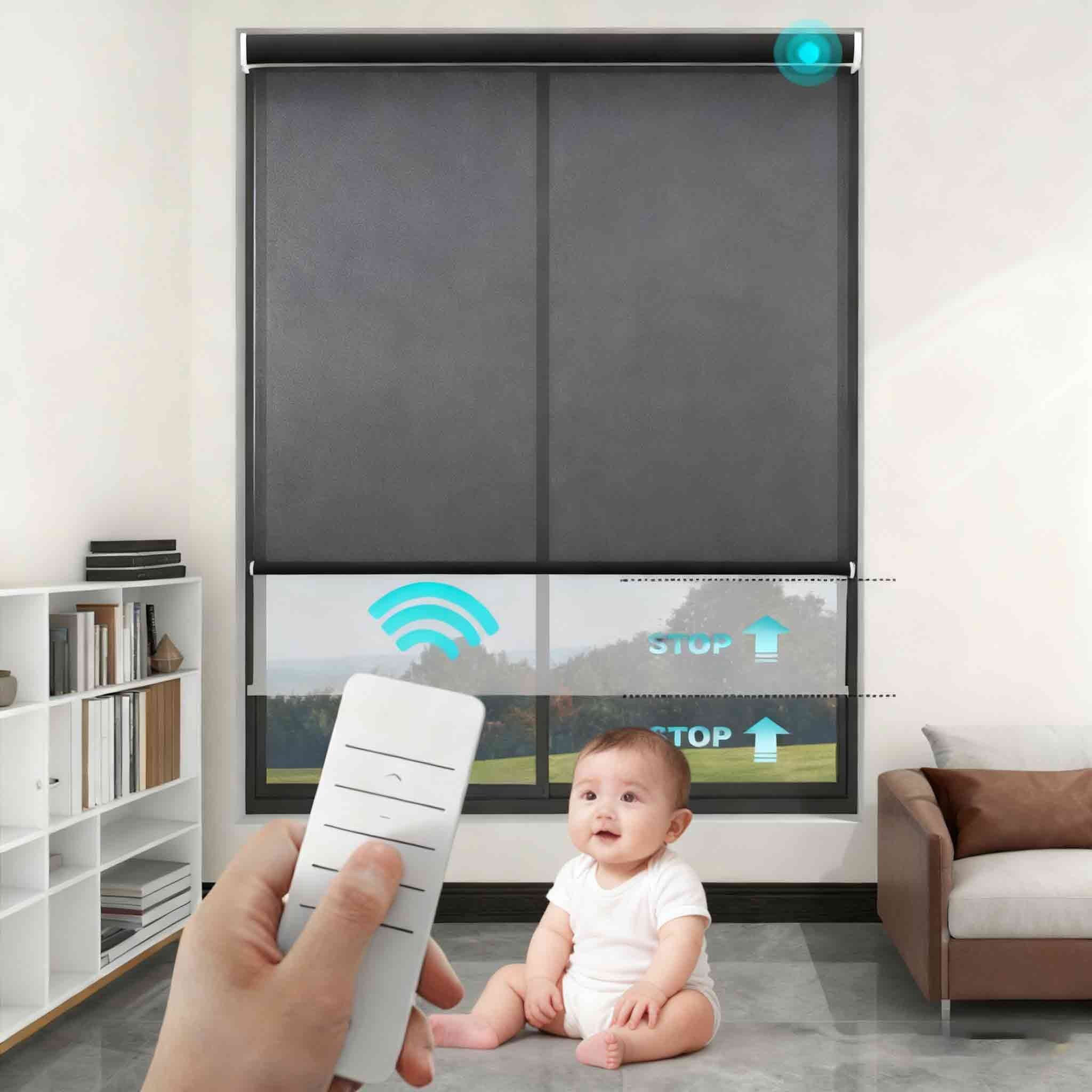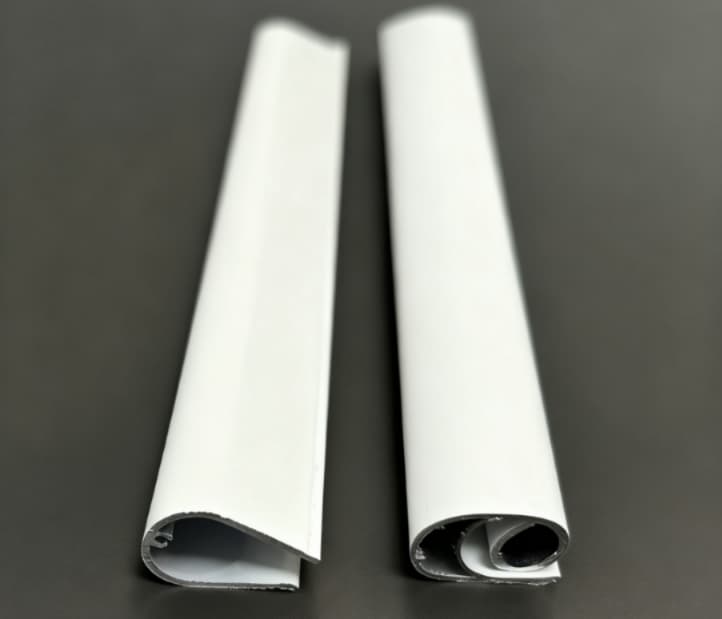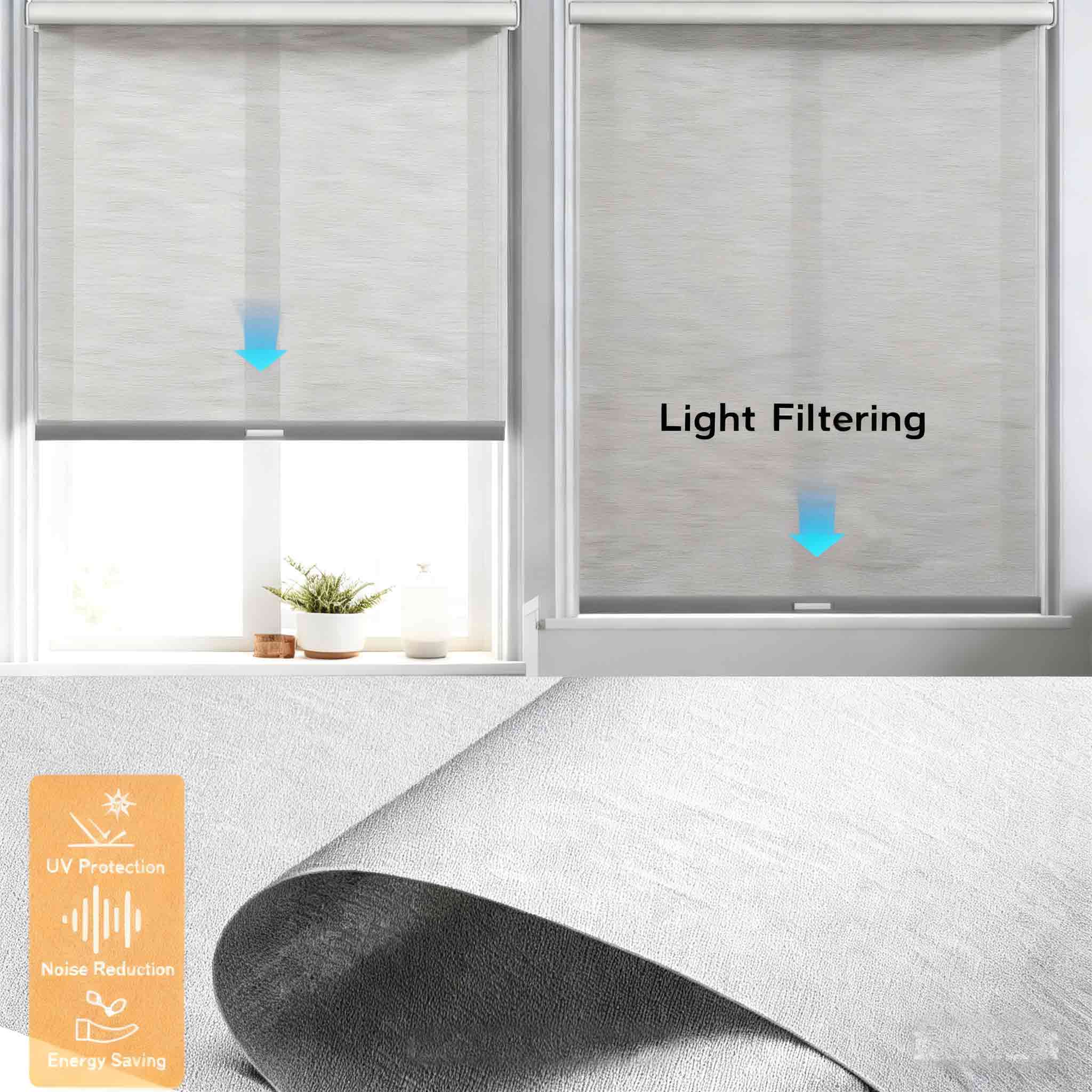This article comprehensively analyzes the engineering logic and application value of cordless light-blocking roller blinds from the perspectives of core technical features, performance verification, material selection, engineering processes, and full-lifecycle maintenance. It aims to provide professional references for adapting to home scenarios.

The technical advantages of cordless light-blocking roller blinds stem from the complete reconstruction of the transmission structure of traditional corded roller blinds. The core design of "spring balance mechanism + track limiting system" not only addresses the safety hazards of traditional products but also achieves dual upgrades in functionality and durability.
The lifting power of cordless light-blocking roller blinds comes from a built-in high-elastic manganese steel spring (with an elastic coefficient typically ranging from 1.2 to 1.5 N/mm). Its design logic relies on forming a dynamic balance between the spring's preload force and the fabric's self-weight. When pushing the roller blind upward, the spring contracts to store potential energy; when pulling it downward, the spring releases potential energy to assist in descending. Ultimately, this enables an operating mode where "smooth lifting and lowering are achieved with manual pushing and pulling". To ensure stability during long-term use, the spring lifespan must meet the requirement of ≥10,000 reciprocating motions (in line with the ISO 9001 mechanical component durability standard), ensuring minimal elastic degradation even with high-frequency use.
1.1.2 Track Limiting System
Traditional corded roller blinds often suffer from inaccurate positioning due to cord slippage. In contrast, cordless models use wear-resistant nylon limiting blocks (with a friction coefficient ≤0.15) inside the track, combined with a slot structure on the crossbar at the bottom of the fabric. This enables the "arbitrary height positioning" function, with a positioning error strictly controlled within ±5 mm. Whether adjusting to a semi-light-blocking state or fully closing the blind, precise fixing is achievable, preventing position deviation from affecting light-blocking efficiency or user experience.
The track adopts a U-shaped fully enclosed structure (with an opening width ≤12 mm). On one hand, this prevents dust from entering the drive mechanism, avoiding mechanical component jamming due to dust accumulation. On the other hand, it completely eliminates safety hazards caused by exposed cords, fully complying with the mandatory standard in the EU's EN 13120 "Safety Requirements for Indoor Sunshading Products for Buildings" that "cordless designs must avoid child entanglement risks". It is particularly suitable for families with children.
The core value of cordless light-blocking roller blinds must be realized through quantifiable technical parameters to meet the practical needs of "completely blocking natural light, enhancing privacy, and improving energy efficiency":
Light-blocking Rate: In accordance with the ASTM D1777 textile light-blocking rate test standard, the measured light-blocking rate under laboratory conditions must be ≥95%, with fully light-blocking models reaching 98%-100%. This indicator ensures that spaces sensitive to light, such as bedrooms and home theaters, can effectively block external light, creating a suitable environment for rest or movie-watching.
Privacy Protection Level: Referring to GB/T 33283 "Textiles - Privacy Evaluation Method", during the day (with an outdoor illuminance of 10,000 lux), it must reach the level of "no visible indoor scenes from the outside"; at night (with an indoor illuminance of 500 lux), it must achieve the level of "only blurry outlines visible". Compared with traditional thin-fabric roller blinds that easily "transmit light and expose scenes", cordless models effectively protect residential privacy and prevent the exposure of daily life scenarios.
Heat Transfer Coefficient (U-value): To meet energy efficiency requirements, the fabric must have excellent thermal insulation performance, with a measured U-value ≤1.8 W/(㎡·K) (in accordance with the ISO 10211 building component heat transfer test standard). This means that in summer, it can reduce the indoor entry of solar radiant heat by 60%-80%, lowering air conditioning loads; in winter, it can reduce indoor heat loss by 20%-30%, helping to improve heating efficiency. Long-term use can significantly save energy costs.
Operating Force: Considering the usability for the elderly and children, the manual operating force must be controlled between 15-30 N (in line with GB/T 30223 "Operating Force Requirements for Indoor Sunshading Products for Household and Similar Purposes").

Traditional corded roller blinds have long had pain points such as "insufficient privacy protection, low energy efficiency, and complex maintenance". Through structural optimization and material upgrades, cordless light-blocking roller blinds have achieved breakthroughs in three key dimensions: safety, functionality, and durability. The following uses international test data to intuitively demonstrate their performance advantages.
The cord entanglement risk of traditional corded roller blinds is a major hidden danger to home safety. According to the 2024 "Child Home Safety Report" by the U.S. Consumer Product Safety Commission (CPSC), there are approximately 200 child suffocation accidents caused by the cords of corded roller blinds each year. Cordless light-blocking roller blinds completely address this issue through two core designs:
Child Safety Verification of Cordless Structure: In accordance with Appendix A "Child Safety Test" of EN 13120, the product was placed in an environment simulating children aged 3-6 at play. The test results showed that "no entanglable components were exposed", and the safety level reached the highest Class A, eliminating entanglement risks from a structural perspective.
Detailed Design for Fall Protection: The crossbar at the bottom of the roller blind is made of high-density ABS material (with an impact strength ≥20 kJ/㎡), and its edges are rounded (with a fillet radius ≥5 mm). Even in the event of an accidental fall, it can prevent sharp edges from causing impact injuries to the human body, complying with the protection requirements for "child-contact components" in GB 6675 "Toy Safety" and further enhancing usage safety.
2.2 Functional Performance: Comprehensive Upgrades in Light Blocking, Energy Saving, and Privacy
To verify the functional advantages of cordless light-blocking roller blinds, the American Association of Textile Chemists and Colorists (AATCC) and the China Building Materials Academy conducted tests in 2024, comparing the core performance indicators of traditional corded roller blinds and cordless models. The results showed that cordless light-blocking roller blinds are significantly superior to traditional ones in terms of light-blocking rate and UV blocking rate. Especially in energy efficiency-related indicators of "summer heat insulation" and "winter heat preservation", the improvement exceeds 150%, fully aligning with the core demand of modern homes for "saving energy costs".
The failure of traditional corded roller blinds mostly stems from issues such as cord wear and chain rust. Through material upgrades and structural simplification, cordless light-blocking roller blinds significantly extend their service life.
| Performance Indicators | Test Standards | Cordless Blackout Roller Blinds | Traditional corded roller blinds (standard fabric) | Performance Improvement |
| Shading Ratio | ASTM D1777 | 95%-100% | 60%-80% | 20%-40% |
| Blocking Ratio | AATCC 183 | 90%-95% | 40%-60% | 50%-80% |
| Summer Insulation (Indoor) | ISO 10211 (35°C outdoor environment) | 3-5°C | 1-2°C | 150%-200% |
| Winter Insulation (Heat Retention) | ISO 10211 (5°C outdoor environment) | 20%-30% Heat Loss Reduction | 5%-10%heat loss reduction | 150%-300% |
| Privacy Level (Daytime) | GB/T 33283 | Completely Blocks Views | Blurred interior view | Level 1 (Highest Level) |
| Operational Strength | GB/T 30223 | 15-30N | 25-40N | 40%-62.5% |
The demand for light-blocking roller blinds in modern homes goes beyond "light blocking"; it also requires "matching with decorative styles" and "adapting to special spaces". From an engineering perspective, this demand must be fulfilled through "material selection + customized design", with the core logic of "function adapting to scenes and materials matching functions".
The following provides selection references based on material performance and scene requirements:From an engineering selection perspective, bedrooms should prioritize "fully light-blocking polyester fabrics"; kitchens require "stain-resistant coated fabrics" to handle oil stains generated during cooking, which can be restored to cleanliness with a damp cloth wipe; living rooms can opt for "thermal insulation cotton-blended fabrics".
| fabric type | Core performance parameters (engineering level) | Applicable scenarios | Advantages and limitations |
| Blackout polyester | 98%-100% shading rate, U-value 1.6W/(m2・K), abrasion resistance ≥ 5000 times | Bedroom, home theater (needs complete darkness) | Advantages: Strong light-blocking properties, washable; Limitations: Average breathability |
| Insulating cotton blend | 90%-95% shading rate, U-value 1.4W/(m2・K), air permeability ≥ 50mm/s | Living room, bedroom (needs energy efficiency and comfort) | Advantages: Good insulation, breathable; Limitations: Higher price |
| Stain-resistant coating | 85%-90% shading rate, stain resistance ≥ Level 4 (ISO 105-E04), scrub resistance ≥ 200 times | Kitchen, children's room (easily dirty) | Advantages: Easy to clean, oil-resistant; Limitations: Slightly lower light-blocking properties |
| Recycled polyester | 90%-95% shading rate, compliant with GRS global recycling standards, U-value 1.7W/(m2・K) | Entire space (for environmentally conscious families) | Advantages: Sustainable, odor-free; Limitations: Limited color options |
In modern homes, non-standard windows such as bay windows, arch windows, and circular windows are becoming increasingly common. Traditional roller blinds struggle to adapt to these, but cordless light-blocking roller blinds can achieve the dual requirements of "precise dimensions + structural adaptation" through customized design:
Dimensional Accuracy Control: For scenarios such as bay windows and large window panes, a laser rangefinder (with an accuracy of ±0.1 mm) is used to measure the window opening size. Track cutting is performed using CNC numerical control cutting (with an accuracy of ±0.5 mm), ensuring a post-installation fit with the window of ≥98% and a light gap width ≤1 mm. This prevents light leakage through gaps from affecting the light-blocking effect, especially suitable for bedroom scenarios sensitive to light.
Structural Adaptation for Special Shapes: For arch and circular windows, a "segmented roller + curved track" design is adopted. The roller is made of flexible stainless steel material (with a bendable radius ≥300 mm) to avoid stress cracking after bending; the track is formed by curved aluminum alloy extrusion (with a curvature error ≤0.5°/m), ensuring a perfect fit with the window's curvature. At the same time, the spring balance parameters are recalculated (adjusting the preload force based on the curved radius) to ensure smooth lifting and lowering without jamming.
Smart Function Customization: To meet smart home needs, "motor linkage + remote control" functions can be customized. The motor uses a DC silent motor (with an operating noise ≤35 dB), supporting APP or voice control. It can be linked with indoor light sensors to realize intelligent operations such as "automatic lowering when light is too strong and automatic rising when light weakens", further enhancing usability.
Selecting cordless light-blocking roller blinds is not a simple process of "choosing fabrics and determining sizes"; it requires a standardized process of "quantitative parameter verification + scene adaptation verification". The following table is a general table used by our customized clients after use.(Please contact us for supply)
Although cordless light-blocking roller blinds have "low maintenance costs and long durability", a standardized maintenance process must be established to ensure stable performance throughout the product's full lifecycle (recommended 8-10 years). The following provides an engineering-level maintenance plan from three dimensions: daily cleaning, drive mechanism maintenance, and fault troubleshooting.

Cleaning methods vary significantly among different fabrics, with the core principles of "gentle cleaning, protecting coatings, and preventing deformation":
Daily Dust Removal: Use a vacuum cleaner (with a brush suction head and power ≤800 W) to vacuum along the fabric texture direction every week. Avoid vertical vacuuming to prevent fabric wrinkling.
Stain Cleaning: Dilute neutral detergent (with a pH value of 6-8) with warm water (≤40℃), dampen a microfiber cloth (with a water content ≤50%), and gently wipe stains in the same direction as the fabric texture (avoid circular wiping to prevent coating peeling).
Drying Treatment: After cleaning, use a dry microfiber cloth to absorb moisture. Avoid drying in direct sunlight (to prevent fabric fading).
Daily Dust Removal: Same as for polyester fabrics, but the vacuum cleaner power should be reduced (≤600 W) to prevent cotton or linen fibers from falling off.
Stain Cleaning: Do not use detergents containing bleaching agents, strong acids, or alkalis. After cleaning, air-dry naturally (avoid drying to prevent fabric shrinkage; the shrinkage rate must be ≤3%, in line with GB/T 8629 "Textiles - Domestic Washing and Drying Procedures for Testing").
Special Notes: Avoid long-term exposure to humid environments (e.g., near bathrooms) to prevent fabric mildew.
The drive mechanism (spring, track, motor) is the "heart" of cordless roller blinds and requires regular maintenance to avoid malfunctions:
Every 3 Months: Spray the inner side of the track and the spring connection with silicone spray (neutral, free of corrosive components) to reduce frictional resistance (spray volume ≤5 ml per time to avoid excessive spray contaminating the fabric).
Every 6 Months: Check the spring preload force. If "automatic sliding downward" is observed during lifting (sliding distance >10 mm/24 hours), contact professionals to adjust the spring preload force (do not disassemble by yourself to prevent injury from spring ejection).
Every 3 Months: Clean the motor heat dissipation holes (using a compressed air can with an air pressure ≤0.3 MPa) to prevent motor overheating caused by dust blockage.
Every 6 Months: Check the motor terminal blocks (ensure no looseness and no damage to the insulation layer). Use a multimeter to test the motor operating current (which should be within ±10% of the rated current; for example, the current of a 15 W motor should be between 0.6-0.7 A).
Every Year: Test the smart control functions (APP, voice control) to ensure a response delay ≤1 second and a timing function error ≤5 minutes, avoiding usage issues caused by software malfunctions.
When malfunctions occur in the roller blind, troubleshooting should follow the process of "starting with simple checks before complex ones, and inspecting external components before internal ones" to avoid blind operations:
Step 1: Check for foreign objects (such as dust, hair, and thread ends) in the track. Remove the foreign objects with tweezers and spray silicone spray.
Step 2: If jamming persists, for manual models, check if the spring is deformed (replace the spring if the straightness error >2 mm); for electric models, check if the motor gear is worn (replace the gear if the gear tooth surface wear >0.2 mm).
Step 1: Check if the fabric is damaged (such as coating peeling or fabric tearing). For small damages (≤2 cm), attach a dedicated repair tape (which must match the fabric color); for large damages, replace the fabric.
Step 2: Check if the installation is displaced (light gap width >1 mm). Readjust the track position to ensure a tight fit with the window.
Step 1: Check the power supply (whether the socket voltage is 220 V ±10%; for battery-powered models, check if the battery level is ≥3.6 V).
Step 2: If the power supply is normal, check the control module (whether the APP is connected to the network and whether the voice assistant is bound to the device). Restart the control module and try again.
Step 3: If there is still no response, use a multimeter to measure the motor winding resistance (which should normally be between 50-100 Ω). If the resistance is infinite, the motor is burned out and needs to be replaced (it is recommended to contact professionals for operation to avoid electric shock).
Cordless light-blocking roller blinds are not just simple "window decorations" but integrated indoor environment solutions that combine "safety assurance, environmental control, and energy conservation". Their application value can be summarized into three key dimensions: safety, functionality, and economy.